Virtual Power Plant with Renewable Energy Sources and Energy Storage Systems for Sustainable Power Grid-Formation, Control Techniques and Demand Response
Abstract
1. Introduction
1.1. Renewable Energy and Distributed Power Grid
- RESs are characterized by uncertainty as they are dependent on weather conditions and geographic locations, which makes these natural resources uncontrollable.
- The intermittent nature of RESs can lead to power imbalances, supply–demand mismatch, and power quality issues in the electricity system.
- The placement of large RES power plants (such as hydropower and wind turbines) is generally far from the power consumption centers, requiring long-distance or inter-regional transmission.
1.2. Virtual Power Plants
- Uncertainty in RESs: As the number of RES integrated into the grid increases, the periodic and stochastic power output will have a certain impact on the operation of the grid. The state-of-the-art day-ahead forecasting methods still have an error rate of 10% for RES output power prediction [19].
- Uncertainty in electricity market prices: In the energy system, market prices change with local policies and weather conditions [20]. Therefore, the price of electricity in the market has a high volatility, which may cause losses to VPP participants.
- Uncertainty in load demand: Load power mainly includes deterministic (affected by factors such as time) and stochastic elements (prediction and measurement errors) [21]. Load demands change with seasons and are related to consumers and unexpected events, making the uncertainty of load demands even more complex [21].
- Summarize the development process of the VPP concept from its introduction to the present, in chronological order, and draw a diagram of the evolution of VPP-related concepts from 1997 to the present so that readers can understand the whole process of VPP concept development.
- Summarize and review existing control techniques for integrating VPPs into sustainable power grids so that researchers can better identify current research gaps.
- The demand side auxiliary services of the VPP can reduce or increase end-user electricity consumption through incentives or price-based voluntary schemes. This enables VPPs to participate in the wholesale electricity market, improve the efficiency of the electricity market, and enhance system reliability. Finally, existing and new models related to D-FCAS are summarized and proposed for the development of VPPs.
2. Development of VPPs
2.1. Evolution of the VPP Concept
2.2. Difference between VPP and MG
- VPPs always exist in grid-connected form (while MGs can be either grid connected or off grid). VPPs are always connected to the power grid and use advanced software to manage a group of DERs. VPPs can dispatch DERs to provide grid services or participate in energy markets. In contrast, MGs can operate in isolation from the grid, known as off-grid mode, or be connected to the grid, known as grid-connected mode. MGs are designed to provide reliable and resilient power supply, especially in remote or critical locations.
- VPPs may or may not have ESSs (while MGs typically require ESSs). A VPP is a cloud-based software platform that aggregates the distributed DERs. Instead of physically connecting them, a VPP manages them as a VPP to provide electricity to the grid in response to demand fluctuations. In contrast, an MG is a small-scale electrical network that can operate independently or in parallel with the main grid. They usually integrate various DERs with ESSs to ensure a reliable and resilient power supply. Therefore, while energy storage is optional for VPPs, it is an essential component of MGs.
- VPPs do not isolate themselves from the larger public grid as an emergency measure (while MGs can). In terms of VPPs and MGs, VPPs do not primarily function as an emergency source for backup power. Instead, they are a collection of energy resources that can be strategized and directed to the power grid in response to energy demand or sudden power fluctuations. On the other hand, MGs are designed to operate as self-contained units, generating and distributing power independently from the main power grid in case of emergencies or planned outages.
- VPPs primarily rely on smart meters and information technology (while MGs rely mainly on hardware such as smart inverters and switches). VPPs rely on smart meters and information technology to manage the energy supply and demand of a network of DERs. VPPs use algorithms and software to analyze data from smart meters and other sensors, which allows them to predict energy usage patterns and optimize the dispatch of energy resources. On the other hand, MGs rely mainly on hardware such as smart inverters and switches to manage the energy flow within a localized area.
- VPPs can combine and coordinate a variety of resources in a larger geographic area (while MGs only include a set of static resources in a limited geographic location). This means that VPPs can access and manage diverse sources of DERs across a wider region. VPPs can then dispatch these resources based on real-time grid conditions and customer demands to provide grid services such as peak shaving, load balancing, and frequency regulation. However, VPPs are difficult to connect in a larger geographical area with weak electrical supply. MGs operate on a smaller scale and typically manage a fixed set of DERs in a specific location. While both concepts involve managing distributed resources, VPPs have a greater ability to optimize a wider range of assets in real time for greater grid resiliency and flexibility.
- VPPs can establish connections with wholesale electricity markets (while MGs only conduct power transactions in a retail manner). This means that VPPs can sell the excess electricity generated by their DERs to the wholesale electricity markets, which can ensure a more cost-effective and efficient use of RESs. Additionally, VPPs can participate in DR programs and provide grid services to the utility, improving grid stability and reliability. In contrast, MGs are limited to retail transactions between DER owners and the end users.
3. Benefit of Forming VPPs
3.1. Economic Impact
3.2. Social Impact
3.3. Environmental Impact
4. Cutting-Edge Control Techniques of VPPs
4.1. Control Framework and Systems of VPPs
- Communication protocol: The communication protocol between the various elements of the VPP must be efficient, reliable, and secure. It should be able to handle large volumes of data in real time with minimal delay.
- Resource management: The VPP control system should be able to allocate resources based on demand and supply. It should be able to balance the load across various energy resources, and ensure that there is always a surplus of energy.
- Prediction and forecasting: The VPP control system should be able to predict the demand for energy and the availability of energy resources. It should be able to use historical data and current trends to forecast the future demand and supply of energy.
- Security: The VPP control system should be secure and be able to prevent unauthorized access and cyber threats. It should be able to monitor the system for any potential security risks, and take appropriate measures to mitigate those risks.
4.2. Hierarchical Control
4.3. Communication Protocols and Security
5. Ancillary Service Provision from VPPs
5.1. VPPs as a Source for D-FCAS
5.2. VPPs Consisting of Interconnected Microgrids for D-FCAS
5.2.1. Day-Ahead Scheduling
5.2.2. Real-Time Power Control
5.3. Possible D-FCAS Paradigm Considering Grid Contingencies
5.3.1. Day-Ahead Scheduling
5.3.2. Real-Time Power Control
5.4. P2P Energy Trading for Distributed Optimization
6. Future Research Directions
- Proposition of policy framework in the energy sector: This refers to the need to change and update the policies and regulations that govern the energy sector to accommodate the technological advances and changing trends in energy production and consumption.
- Hardware implementation of VPP control mechanisms: VPP control mechanisms are complex systems with power electronics devices and software control and communication protocols, which enable the aggregation, control, and dispatch of DERs within a VPP.
- New market regulations: Market regulations need to evolve to allow for the integration of VPPs into the energy market. This includes establishing new market structures and rules to support the use of VPPs.
- Secure communications: As VPPs rely on communication between various components, ensuring that these communications are secure is essential to prevent hacking and data breaches.
- Planning of infrastructure and necessary facilities for VPPs: The integration of VPPs in the energy sector requires strategic planning of next-generation infrastructure, such as high-efficiency renewable generators, storage systems, standby generators, and flexible loads.
7. Conclusions
Author Contributions
Funding
Conflicts of Interest
References
- Baños, R.; Manzano-Agugliaro, F.; Montoya, F.G.; Gil, C.; Alcayde, A.; Gómez, J. Optimization methods applied to renewable and sustainable energy: A review. Renew. Sustain. Energy Rev. 2011, 15, 1753–1766. [Google Scholar] [CrossRef]
- Martinez-Frias, J.; Aceves, S.M.; Ray Smith, J.; Brandt, H. A Coal-Fired Power Plant with Zero-Atmospheric Emissions. ASME J. Eng. Gas Turbines Power 2008, 130, 023005. [Google Scholar] [CrossRef]
- Zhao, J.; Patwary, A.K.; Qayyum, A.; Alharthi, M.; Bashir, F.; Mohsin, M.; Hanif, I.; Abbas, Q. The determinants of renewable energy sources for the fueling of green and sustainable economy. Energy 2022, 238, 122029. [Google Scholar] [CrossRef]
- Ritchie, H.; Roser, M.; Rosado, P. Energy. Published Online at Our World in Data. 2022. Available online: https://ourworldindata.org/renewable-energy#citation (accessed on 4 March 2023).
- Zhang, G.; Jiang, C.; Wang, X. Comprehensive review on structure and operation of virtual power plant in electrical system. IET Gener. Transm. Distrib. 2019, 13, 145–156. [Google Scholar] [CrossRef]
- Guney, M.S.; Tepe, Y. Classification and assessment of energy storage systems. Renew. Sustain. Energy Rev. 2017, 75, 1187–1197. [Google Scholar] [CrossRef]
- Zhang, G.; Yuan, J.; Li, Z.; Yu, S.S.; Chen, S.; Trinh, H.; Zhang, Y. Forming a Reliable Hybrid Microgrid Using Electric Spring Coupled With Non-Sensitive Loads and ESS. IEEE Trans. Smart Grid 2020, 11, 2867–2879. [Google Scholar] [CrossRef]
- Mulleriyawage, U.G.K.; Shen, W. Optimally sizing of battery energy storage capacity by operational optimization of residential PV-Battery systems: An Australian household case study. Renew. Energy 2020, 160, 852–864. [Google Scholar] [CrossRef]
- Billinton, R.; Karki, R.; Gao, Y.; Huang, D.; Hu, P.; Wangdee, W. Adequacy assessment considerations in wind integrated power systems. IEEE Trans. Power Syst. 2012, 27, 2297–2305. [Google Scholar] [CrossRef]
- Krishan, O.; Suhag, S. An updated review of energy storage systems: Classification and applications in distributed generation power systems incorporating renewable energy resources. Int. J. Energy Res. 2019, 43, 6171–6210. [Google Scholar] [CrossRef]
- Liu, B.; Zhuo, F.; Zhu, Y.; Yi, H. System Operation and Energy Management of a Renewable Energy-Based DC Micro-Grid for High Penetration Depth Application. IEEE Trans. Smart Grid 2015, 6, 1147–1155. [Google Scholar] [CrossRef]
- Bialasiewicz, J.T. Renewable Energy Systems with Photovoltaic Power Generators: Operation and Modeling. IEEE Trans. Ind. Electron. 2008, 55, 2752–2758. [Google Scholar] [CrossRef]
- Babatunde, O.M.; Munda, J.L.; Hamam, Y. Power system flexibility: A review. Energy Rep. 2020, 6, 101–106. [Google Scholar] [CrossRef]
- Naval, N.; Yusta, J.M. Virtual power plant models and electricity markets—A review. Renew. Sustain. Energy Rev. 2021, 149, 111393. [Google Scholar] [CrossRef]
- Nosratabadi, S.M.; Hooshmand, R.A.; Gholipour, E. A comprehensive review on microgrid and virtual power plant concepts employed for distributed energy resources scheduling in power systems. Renew. Sustain. Energy Rev. 2017, 67, 341–363. [Google Scholar] [CrossRef]
- Bhuiyan, E.A.; Hossain, M.Z.; Muyeen, S.M.; Fahim, S.R.; Sarker, S.K.; Das, S.K. Towards next generation virtual power plant: Technology review and frameworks. Renew. Sustain. Energy Rev. 2021, 150, 111358. [Google Scholar] [CrossRef]
- Alahyari, A.; Ehsan, M.; Mousavizadeh, M. A hybrid storage-wind virtual power plant (VPP) participation in the electricity markets: A self-scheduling optimization considering price, renewable generation, and electric vehicles uncertainties. J. Energy Storage 2019, 25, 100812. [Google Scholar] [CrossRef]
- Yu, S.; Fang, F.; Liu, Y.; Liu, J. Uncertainties of virtual power plant: Problems and countermeasures. Appl. Energy 2019, 239, 454–470. [Google Scholar] [CrossRef]
- Kong, J.; Oh, S.; Kang, B.O.; Jung, J. Development of an incentive model for renewable energy resources using forecasting accuracy in South Korea. Energy Sci. Eng. 2022, 10, 3250–3266. [Google Scholar] [CrossRef]
- Shabanzadeh, M.; Sheikh-El-Eslami, M.K.; Haghifam, M.R. A medium-term coalition-forming model of heterogeneous DERs for a commercial virtual power plant. Appl. Energy 2016, 169, 663–681. [Google Scholar] [CrossRef]
- Zamani, A.G.; Zakariazadeh, A.; Jadid, S. Day-ahead resource scheduling of a renewable energy based virtual power plant. Appl. Energy 2016, 169, 324–340. [Google Scholar] [CrossRef]
- Przychodzień, A. Virtual power plants—Types and development opportunities. In Proceedings of the E3S Web of Conferences XIV Research & Development in Power Engineering, Warsaw, Poland, 3–6 December 2019. [Google Scholar]
- Othman, M.M.; Hegazy, Y.G.; Abdelaziz, A.Y. A Review of virtual power plant definitions, components, framework and optimization. Int. Electr. Eng. J. 2015, 6, 2010–2024. [Google Scholar]
- Ghavidel, S.; Li, L.; Aghaei, J.; Yu, T.; Zhu, J. A review on the virtual power plant: Components and operation systems. In Proceedings of the IEEE International Conference on Power System Technology (POWERCON), Wollongong, NSW, Australia, 28 September–1 October 2016. [Google Scholar]
- Lv, M.; Lou, S.; Liu, B.; Fan, Z.; Wu, Z. Review on power generation and bidding optimization of virtual power plant. In Proceedings of the International Conference on Electrical Engineering and Informatics (ICELTICs), Banda Aceh, Indonesia, 18–20 October 2017. [Google Scholar]
- Shen, J.; Jiang, C.; Li, B. Controllable load management approaches in smart grids. Energies 2015, 8, 11187–11202. [Google Scholar] [CrossRef]
- Rouzbahani, H.M.; Karimipour, H.; Lei, L. A review on virtual power plant for energy management. Sustain. Energy Technol. Assess. 2021, 47, 101370. [Google Scholar] [CrossRef]
- Venegas-Zarama, J.F.; Muñoz-Hernandez, J.I.; Baringo, L.; Diaz-Cachinero, P.; Domingo-Mondejar, D. A Review of the Evolution and Main Roles of Virtual Power Plants as Key Stakeholders in Power Systems. IEEE Access 2022, 10, 47937–47964. [Google Scholar] [CrossRef]
- Adu-Kankam, K.O.; Camarinha-Matos, L.M. Towards collaborative virtual power plants: Trends and convergence. Sustain. Energy Grids Netw. 2018, 16, 217–230. [Google Scholar] [CrossRef]
- Kazmi, S.A.A.; Shahzad, M.K.; Khan, A.Z.; Shin, D.R. Smart distribution networks: A review of modern distribution concepts from a planning perspective. Energies 2017, 10, 501. [Google Scholar] [CrossRef]
- Awerbuch, S.; Preston, A. The Virtual Utility: Accounting, Technology & Competitive Aspects of the Emerging Industry; Springer: Berlin/Heidelberg, Germany, 1997. [Google Scholar]
- Dielmann., K.; van der Velden, A. Virtual power plants (VPP)—A new perspective for energy generation? In Proceedings of the 9th International Scientific and Practical Conference of Students, Post-graduates Modern Techniques and Technologies, 2003. MTT 2003, Tomsk, Russia, 7–11 April 2003. [Google Scholar]
- Caldon, R.; Patria, A.R.; Turri, R. Optimisation algorithm for a virtual power plant operation. In Proceedings of the 39th International Universities Power Engineering Conference, 2004. UPEC 2004, Bristol, UK, 6–8 September 2004. [Google Scholar]
- Pudjianto, D.; Ramsay, C.; Strbac, G. Virtual power plant and system integration of distributed energy resources. Renew. Power Gener. IET 2007, 1, 10–16. [Google Scholar] [CrossRef]
- Pudjianto, D.; Ramsay, C.; Strbac, G. Microgrids and virtual power plants: Concepts to support the integration of distributed energy resources. Proc. Inst. Mech. Eng. Part A J. Power Energy 2008, 222, 731–741. [Google Scholar] [CrossRef]
- Ruiz, N.; Cobelo, I.; Oyarzabal, J. A Direct Load Control Model for Virtual Power Plant Management. IEEE Trans. Power Syst. 2009, 24, 959–966. [Google Scholar] [CrossRef]
- Asmus, P. Microgrids, Virtual Power Plants and Our Distributed Energy Future. Electr. J. 2010, 23, 72–82. [Google Scholar] [CrossRef]
- Mashhour, E.; Moghaddas-Tafreshi, S.M. Bidding Strategy of Virtual Power Plant for Participating in Energy and Spinning Reserve Markets—Part II: Numerical Analysis. IEEE Trans. Power Syst. 2011, 26, 957–964. [Google Scholar] [CrossRef]
- Bremer, J.; Sonnenschein, M. Parallel tempering for constrained many criteria optimization in dynamic virtual power plants. In Proceedings of the 2014 IEEE Symposium on Computational Intelligence Applications in Smart Grid (CIASG), Orlando, FL, USA, 9–12 December 2014. [Google Scholar]
- Al-Awami, A.T.; Amleh, N.A.; Muqbel, A.M. Optimal Demand Response Bidding and Pricing Mechanism with Fuzzy Optimization: Application for a Virtual Power Plant. IEEE Trans. Ind. Appl. 2017, 53, 5051–5061. [Google Scholar] [CrossRef]
- Koraki, D.; Strunz, K. Wind and Solar Power Integration in Electricity Markets and Distribution Networks Through Service-Centric Virtual Power Plants. IEEE Trans. Power Syst. 2018, 33, 473–485. [Google Scholar] [CrossRef]
- Liu, J.; Yu, S.S.; Hu, H.; Zhao, J.; Trinh, H. Demand-side regulation provision of virtual power plants consisting of interconnected microgrids through double-stage double-layer optimization. IEEE Trans. Smart Grid 2022, 14, 1946–1957. [Google Scholar] [CrossRef]
- Wang, T.; O’Neill, D.; Kamath, H. Dynamic Control and Optimization of Distributed Energy Resources in a Microgrid. IEEE Trans. Smart Grid 2015, 6, 2884–2894. [Google Scholar] [CrossRef]
- Pedrasaa, M.A.A.; Spoonerb, T.D.; MacGillb, I.F. A novel energy service model and optimal scheduling algorithm for residential distributed energy resources. Electr. Power Syst. Res. 2011, 81, 2155–2163. [Google Scholar] [CrossRef]
- Yavuz, L.; Önen, A.; Muyeen, S.M.; Kamwa, I. Transformation of microgrid to virtual power plant–a comprehensive review. IET Gener. Transm. Distrib. 2019, 13, 1994–2005. [Google Scholar] [CrossRef]
- Tajeddini, M.A.; Rahimi-Kian, A.; Soroudi, A. Risk averse optimal operation of a virtual power plant using two stage stochastic programming. Energy 2014, 73, 958–967. [Google Scholar] [CrossRef]
- Thavlov, A.; Bindner, H.W. Utilization of Flexible Demand in a Virtual Power Plant Set-Up. IEEE Trans. Smart Grid 2015, 6, 640–647. [Google Scholar] [CrossRef]
- Duc, H.N.; Hong, N.N. Optimal Reserve and Energy Scheduling for a Virtual Power Plant Considering Reserve Activation Probability. Appl. Sci. 2021, 11, 9717. [Google Scholar]
- Chau, T.K.; Yu, S.S.; Fernando, T.; Iu, H.H.-C. Demand-Side Regulation Provision from Industrial Loads Integrated with Solar PV Panels and Energy Storage System for Ancillary Services. IEEE Trans. Ind. Inform. 2018, 14, 5038–5049. [Google Scholar] [CrossRef]
- Liang, Z.; Alsafasfeh, Q.; Jin, T.; Pourbabak, H.; Su, W. Risk-Constrained Optimal Energy Management for Virtual Power Plants Considering Correlated Demand Response. IEEE Trans. Smart Grid 2019, 10, 1577–1587. [Google Scholar] [CrossRef]
- Sučić, S.; Dragičević, T.; Capuder, T.; Delimar, M. Economic dispatch of virtual power plants in an event-driven service-oriented framework using standards-based communications. Electr. Power Syst. Res. 2011, 81, 2108–2119. [Google Scholar] [CrossRef]
- Jiao, F.; Ren, C.; Ai, J.; Zhang, J.; Lu, Z. Research on Virtual Power Plant Operation Mechanism under the Background of Coordinated Development of Carbon Market and Power Market. In Proceedings of the 2021 Smart City Challenges & Outcomes for Urban Transformation (SCOUT), Bhubaneswar, India, 25–26 December 2021. [Google Scholar]
- Ochoa, D.E.; Galarza-Jimenez, F.; Wilches-Bernal, F.; Schoenwald, D.A.; Poveda, J.I. Control Systems for Low-Inertia Power Grids: A Survey on Virtual Power Plants. IEEE Access 2023, 11, 20560–20581. [Google Scholar] [CrossRef]
- Baimel, D.; Belikov, J.; Guerrero, J.M.; Levron, Y. Dynamic Modeling of Networks, Microgrids, and Renewable Sources in the dq0 Reference Frame: A Survey. IEEE Access 2017, 5, 21323–21335. [Google Scholar] [CrossRef]
- Marinescu, B.; Gomis-Bellmunt, O.; Dörfler, F.; Schulte, H.; Sigrist, L. Dynamic Virtual Power Plant: A New Concept for Grid Integration of Renewable Energy Sources. IEEE Access 2022, 10, 104980–104995. [Google Scholar] [CrossRef]
- Chau, T.K.; Yu, S.S.; Fernando, T.L.; Iu, H.H.-C.; Small, M. A Novel Control Strategy of DFIG Wind Turbines in Complex Power Systems for Enhancement of Primary Frequency Response and LFOD. IEEE Trans. Power Syst. 2018, 33, 1811–1823. [Google Scholar] [CrossRef]
- Bao, P.; Zhang, W.; Zhang, Y. Secondary Frequency Control Considering Optimized Power Support from Virtual Power Plant Containing Aluminum Smelter Loads Through VSC-HVDC Link. J. Mod. Power Syst. Clean Energy 2023, 11, 355–367. [Google Scholar] [CrossRef]
- Tian, Z.; Wang, Z.; Chong, D.; Wang, J.; Yan, J. Coordinated control strategy assessment of a virtual power plant based on electric public transportation. J. Energy Storage 2023, 59, 106380. [Google Scholar] [CrossRef]
- Liu, Y.; Li, Y.; Wang, Y.; Zhu, J.; Gooi, H.B.; Xin, H. Distributed Real-Time Multi-Objective Control of a Virtual Power Plant in DC Distribution Systems. IEEE Trans. Power Deliv. 2022, 37, 1876–1887. [Google Scholar] [CrossRef]
- Gough, M.; Santos, S.F.; Lotfi, M.; Javadi, M.S.; Osório, G.J.; Ashraf, P.; Castro, R.; Catalão, J.P.S. Operation of a Technical Virtual Power Plant Considering Diverse Distributed Energy Resources. IEEE Trans. Ind. Appl. 2022, 58, 2547–2558. [Google Scholar] [CrossRef]
- Hu, Q.; Han, R.; Quan, X.; Wu, Z.; Tang, C.; Li, W.; Wang, W. Grid-forming inverter enabled virtual power plants with inertia support capability. IEEE Trans. Smart Grid 2022, 13, 4134–4143. [Google Scholar] [CrossRef]
- Park, H.; Ko, W. A Bi-Level Scheduling Model of the Distribution System with a Distribution Company and Virtual Power Plants Considering Grid Flexibility. IEEE Access 2022, 10, 36711–36724. [Google Scholar] [CrossRef]
- Liu, H.; Wang, C.; Ju, P.; Xu, Z.; Lei, S. A Bi-Level Coordinated Dispatch Strategy for Enhancing Resilience of Electricity-Gas System Considering Virtual Power Plants. Int. J. Electr. Power Energy Syst. 2022, 147, 108787. [Google Scholar] [CrossRef]
- Häberle, V.; Fisher, M.W.; Prieto-Araujo, E.; Dörfler, F. Control Design of Dynamic Virtual Power Plants: An Adaptive Divide-and-Conquer Approach. IEEE Trans. Power Syst. 2022, 37, 4040–4053. [Google Scholar] [CrossRef]
- Bahloul, M.; Breathnach, L.; Cotter, J.; Daoud, M.; Saif, A.; Khadem, S. Role of Aggregator in Coordinating Residential Virtual Power Plant in “StoreNet”: A Pilot Project Case Study. IEEE Trans. Sustain. Energy 2022, 13, 2148–2158. [Google Scholar] [CrossRef]
- Li, S.; Wu, W.; Lin, Y. Robust Data-Driven and Fully Distributed Volt/VAR Control for Active Distribution Networks with Multiple Virtual Power Plants. IEEE Trans. Smart Grid 2022, 13, 2627–2638. [Google Scholar] [CrossRef]
- Yi, Z.; Xu, Y.; Wang, X.; Gu, W.; Sun, H.; Wu, Q.; Wu, C. An Improved Two-Stage Deep Reinforcement Learning Approach for Regulation Service Disaggregation in a Virtual Power Plant. IEEE Trans. Smart Grid 2022, 13, 2844–2858. [Google Scholar] [CrossRef]
- Oshnoei, A.; Kheradmandi, M.; Blaabjerg, F.; Hatziargyriou, N.D.; Muyeen, S.M.; Anvari-Moghaddam, A. Coordinated control scheme for provision of frequency regulation service by virtual power plants. Appl. Energy 2022, 325, 119734. [Google Scholar] [CrossRef]
- Xu, Q.; Cao, Y.; Zhang, H.; Zhang, W.; Terzija, V. Bi-level dispatch and control architecture for power system in China based on grid-friendly virtual power plant. Appl. Sci. 2021, 11, 1282. [Google Scholar] [CrossRef]
- Naughton, J.; Wang, H.; Cantoni, M.; Mancarella, P. Co-Optimizing Virtual Power Plant Services Under Uncertainty: A Robust Scheduling and Receding Horizon Dispatch Approach. IEEE Trans. Power Syst. 2021, 36, 3960–3972. [Google Scholar] [CrossRef]
- Rädle, S.; Mast, J.; Gerlach, J.; Bringmann, O. Computational intelligence based optimization of hierarchical virtual power plants. Energy Syst. 2021, 12, 517–544. [Google Scholar] [CrossRef]
- Wang, W.; Chen, P.; Zeng, D.; Liu, J. Electric Vehicle Fleet Integration in a Virtual Power Plant with Large-Scale Wind Power. IEEE Trans. Ind. Appl. 2020, 56, 5924–5931. [Google Scholar] [CrossRef]
- Summeren, L.M.F.; Wieczorek, A.J.; Bombaerts, G.J.T.; Verbong, G.P.J. Community energy meets smart grids: Reviewing goals, structure, and roles in Virtual Power Plants in Ireland, Belgium and the Netherlands. Energy Res. Soc. Sci. 2021, 63, 101415. [Google Scholar] [CrossRef]
- Liu, Y.; Singh, A.K.; Zhao, J.; Meliopoulos, A.P.S.; Pal, B.; Ariff, M.A.M.; Van Cutsem, T.; Glavic, M.; Huang, Z.; Kamwa, I.; et al. Dynamic State Estimation for Power System Control and Protection. IEEE Trans. Power Syst. 2021, 36, 5909–5921. [Google Scholar] [CrossRef]
- Yu, D.; Li, K.; Yu, S.; Trinh, H.; Zhang, P.; Oo, A.M.T.; Hu, Y. A Novel Power and Signal Composite Modulation Approach to Powerline Data Communication for SRM in Distributed Power Grids. IEEE Trans. Power Electron. 2021, 36, 10436–10446. [Google Scholar] [CrossRef]
- Lei, J.; Junaid, M.; Yu, D.; Hua, Z.; Yu, S. A Double-Side Feedback Pulse Train Control for the Output Voltage Regulation of Two-Stage Wireless Power Transfer System. Appl. Sci. 2022, 12, 8991. [Google Scholar] [CrossRef]
- Yan, Y.; Qian, Y.; Sharif, H.; Tipper, D. A Survey on Smart Grid Communication Infrastructures: Motivations, Requirements and Challenges. IEEE Commun. Surv. Tutor. 2013, 15, 5–20. [Google Scholar] [CrossRef]
- Kolenc, M.; Suljanović, N.; Nemček, P.; Zajc, M. Monitoring communication QoS parameters of distributed energy resources. In Proceedings of the 2016 IEEE International Energy Conference (ENERGYCON), Leuven, Belgium, 4–8 April 2016. [Google Scholar]
- Lazović, Đ.; Đurišić, Ž. Advanced Flexibility Support through DSO-Coordinated Participation of DER Aggregators in the Balancing Market. Energies 2023, 16, 3440. [Google Scholar] [CrossRef]
- Diaz-Londono, C.; Correa-Florez, C.A.; Vuelvas, J.; Mazza, A.; Ruiz, F.; Chicco, G. Coordination of specialised energy aggregators for balancing service provision. Sustain. Energy Grids Netw. 2022, 32, 100817. [Google Scholar] [CrossRef]
- Mohy-ud-din, G.; Muttaqi, K.M.; Sutanto, D. A Hierarchical Service Restoration Framework for Unbalanced Active Distribution Networks Based on DSO and VPP Coordination. IEEE Trans. Ind. Appl. 2022, 58, 1756–1770. [Google Scholar] [CrossRef]
- Baimel, D.; Tapuchi, S.; Baimel, N. Smart grid communication technologies-overview, research challenges and opportunities. In Proceedings of the 2016 International Symposium on Power Electronics, Electrical Drives, Automation and Motion (SPEEDAM), Capri, Italy, 22–24 June 2016. [Google Scholar]
- Cao, C.; Xie, J.; Yue, D.; Huang, C.; Wang, J.; Xu, S.; Chen, X. Distributed economic dispatch of virtual power plant under a non-ideal communication network. Energies 2017, 10, 235. [Google Scholar] [CrossRef]
- Nadeem, F.; Aftab, M.A.; Hussain, S.S.; Ali, I.; Tiwari, P.K.; Goswami, A.K.; Ustun, T.S. Virtual power plant management in smart grids with XMPP based IEC 61850 communication. Energies 2019, 12, 2398. [Google Scholar] [CrossRef]
- Etherden, N.; Vyatkin, V.; Bollen, M.H.J. Virtual Power Plant for Grid Services Using IEC 61850. IEEE Trans. Ind. Inform. 2016, 12, 437–447. [Google Scholar] [CrossRef]
- IEC 60870-5-104, Telecontrol Equipment and Systems—Part 5–104: Transmission Protocols—Network Access for IEC 60870-5-101 Using Standard Transport Profiles, 2.0. IEC: Geneva, Switzerland, 2006.
- Kolenc, M.; Ihle, N.; Gutschi, C.; Nemček, P.; Breitkreuz, T.; Goedderz, K.; Suljanović, N.; Zajc, M. Virtual power plant architecture using OpenADR 2.0 b for dynamic charging of automated guided vehicles. Int. J. Electr. Power Energy Syst. 2019, 104, 370–382. [Google Scholar] [CrossRef]
- Rangelov, Y.; Nikolaev, N.; Ivanova, M. The IEC 61850 standard—Communication networks and automation systems from an electrical engineering point of view. In Proceedings of the 2016 19th International Symposium on Electrical Apparatus and Technologies (SIELA), Bourgas, Bulgaria, 29 May–1 June 2016. [Google Scholar]
- Kesavan, T.; Lakshmi, K. Optimization of a Renewable Energy Source-Based Virtual Power Plant for Electrical Energy Management in an Unbalanced Distribution Network. Sustainability 2022, 14, 11129. [Google Scholar] [CrossRef]
- Liu, Y.; Li, M.; Lian, H.; Tang, X.; Liu, C.; Jiang, C. Optimal dispatch of virtual power plant using interval and deterministic combined optimization. Int. J. Electr. Power Energy Syst. 2018, 102, 235–244. [Google Scholar] [CrossRef]
- H2020 eDREAM, Deliverable D3.3-Consumption Flexibility Models and Aggregation Techniques. Available online: https://edream-h2020.eu/wp-content/uploads/2019/07/eDREAM.D3.3.TUC_.WP3_.V1.0-compressed.pdf (accessed on 22 March 2023).
- Fusco, A.; Gioffrè, D.; Castelli, A.F.; Bovo, C.; Martelli, E. A multi-stage stochastic programming model for the unit commitment of conventional and virtual power plants bidding in the day-ahead and ancillary services markets. Appl. Energy 2023, 336, 120739. [Google Scholar] [CrossRef]
- Chung, H.M.; Maharjan, S.; Zhang, Y.; Eliassen, F.; Strunz, K. Optimal Energy Trading with Demand Responses in Cloud Computing Enabled Virtual Power Plant in Smart Grids. IEEE Trans. Cloud Comput. 2022, 10, 17–30. [Google Scholar] [CrossRef]
- Liang, H.; Ma, J. Data-Driven Resource Planning for Virtual Power Plant Integrating Demand Response Customer Selection and Storage. IEEE Trans. Ind. Inform. 2022, 18, 1833–1844. [Google Scholar] [CrossRef]
- Chen, W.; Qiu, J.; Chai, Q. Customized Critical Peak Rebate Pricing Mechanism for Virtual Power Plants. IEEE Trans. Sustain. Energy 2021, 12, 2169–2183. [Google Scholar]
- Chen, W.; Qiu, J.; Zhao, J.; Chai, Q.; Dong, Z.Y. Bargaining Game-Based Profit Allocation of Virtual Power Plant in Frequency Regulation Market Considering Battery Cycle Life. IEEE Trans. Smart Grid 2021, 12, 2913–2928. [Google Scholar] [CrossRef]
- Bao, P.; Zhang, W.; Cheng, D.; Liu, M. Hierarchical control of aluminum smelter loads for primary frequency support considering control cost. Int. J. Electr. Power Energy Syst. 2020, 122, 106202. [Google Scholar] [CrossRef]
- Pop, C.; Antal, M.; Cioara, T.; Anghel, I.; Salomie, I.; Bertoncini, M. A Fog Computing Enabled Virtual Power Plant Model for Delivery of Frequency Restoration Reserve Services. Sensors 2019, 19, 4688. [Google Scholar] [CrossRef]
- Tang, W.; Yang, H. Optimal Operation and Bidding Strategy of a Virtual Power Plant Integrated with Energy Storage Systems and Elasticity Demand Response. IEEE Access 2019, 7, 79798–79809. [Google Scholar] [CrossRef]
- Hu, S.; Xiang, Y.; Liu, J.; Gu, C.; Zhang, X.; Tian, Y.; Liu, Z.; Xiong, J. Agent-Based Coordinated Operation Strategy for Active Distribution Network with Distributed Energy Resources. IEEE Trans. Ind. Appl. 2019, 55, 3310–3320. [Google Scholar] [CrossRef]
- Rossi, A.; Stabile, M.; Puglisi, C.; Falabretti, D.; Merlo, M. Evaluation of the energy storage systems impact on the Italian ancillary market. Sustain. Energy Grids Netw. 2019, 17, 100178. [Google Scholar] [CrossRef]
- Zhang, X.; Hug, G.; Kolter, J.Z.; Harjunkoski, I. Demand Response of Ancillary Service from Industrial Loads Coordinated with Energy Storage. IEEE Trans. Power Syst. 2018, 33, 951–961. [Google Scholar] [CrossRef]
- Giovanelli, C.; Sierla, S.; Ichise, R.; Vyatkin, V. Exploiting artificial neural networks for the prediction of ancillary energy market prices. Energies 2018, 11, 1906. [Google Scholar] [CrossRef]
- Wang, J.; Shen, X.; Xu, Y.; Guo, Q.; Sun, H.; Chen, Y. Ancillary service for frequency regulation based on multi-energy virtual power plant aggregating factory load. In Proceedings of the 11th IET International Conference on Advances in Power System Control, Operating and Management (APSCOM 2018), Hong Kong, China, 11–15 November 2018. [Google Scholar]
- Zhang, X.; Hug, G.; Harjunkoski, I. Cost-Effective Scheduling of Steel Plants with Flexible EAFs. IEEE Trans. Smart Grid 2017, 8, 239–249. [Google Scholar] [CrossRef]
- Electric Grid Test Case Repository. Available online: https://electricgrids.engr.tamu.edu/electric-grid-test-cases/new-england-68-bus-test-system/ (accessed on 4 April 2023).
- Wang, Z.; Chen, B.; Wang, J.; Chen, C. Networked microgrids for self-healing power systems. IEEE Trans. Smart Grid 2016, 7, 310–319. [Google Scholar] [CrossRef]
- The National Solar Radiation Database (NSRDB). Available online: https://nsrdb.nrel.gov/ (accessed on 4 April 2023).
- Li, Z.; Wang, C.; Li, B.; Wang, J.; Zhao, P.; Zhu, W.; Yang, M.; Ding, Y. Probability-interval-based optimal planning of integrated energy system with uncertain wind power. IEEE Trans. Ind. Appl. 2019, 56, 4–13. [Google Scholar] [CrossRef]
- Wen, Y.; Lu, Y.; Gou, J.; Liu, F.; Tang, Q.; Wang, R. Robust Transmission Expansion Planning of Ultrahigh-Voltage AC–DC Hybrid Grids. IEEE Trans. Ind. Appl. 2022, 58, 3294–3302. [Google Scholar] [CrossRef]
- Best, R.J.; Brogan, P.V.; Morrow, D.J. Power system inertia estimation using HVDC power perturbations. IEEE Trans. Power Syst. 2020, 36, 1890–1899. [Google Scholar] [CrossRef]
- Muzhikyan, A.; Mezher, T.; Farid, A.M. Power system enterprise control with inertial response procurement. IEEE Trans. Power Syst. 2017, 33, 3735–3744. [Google Scholar] [CrossRef]
- Zhang, M.; Li, W.; Yu, S.S.; Wen, K.; Muyeen, S.M. Day-ahead optimization dispatch strategy for large-scale battery energy storage considering multiple regulation and prediction failures. Energy 2023, 270, 126945. [Google Scholar] [CrossRef]
- Li, Z.; Li, W.; Yu, S.S.; Guo, L.; Zheng, H.; Ma, J.; Zhao, L.; Dou, W.; Zhang, N. Fast Frequency Response Reserve Planning for Power Systems Considering Homogeneous Extreme Risks. IEEE Trans. Ind. Appl. 2023, 59, 2314–2325. [Google Scholar] [CrossRef]
- He, G.; Chen, Q.; Kang, C.; Pinson, P.; Xia, Q. Optimal Bidding Strategy of Battery Storage in Power Markets Considering Performance-Based Regulation and Battery Cycle Life. IEEE Trans. Smart Grid 2016, 7, 2359–2367. [Google Scholar] [CrossRef]
- Lopez, H.K.; Zilouchian, A. Peer-to-peer energy trading for photo-voltaic prosumers. Energy 2022, 263, 125563. [Google Scholar] [CrossRef]
- Seyedhossein, S.S.; Moeini-Aghtaie, M. Risk management framework of peer-to-peer electricity markets. Energy 2022, 261, 1252. [Google Scholar] [CrossRef]
- Wang, L.; Zhou, Q.; Xiong, Z.; Zhu, Z.; Jiang, C.; Xu, R.; Li, Z. Security constrained decentralized peer-to-peer transactive energy trading in distribution systems. CSEE J. Power Energy Syst. 2022, 8, 188–197. [Google Scholar]
- Li, J.; Xu, D.; Wang, J.; Zhou, B.; Wang, M.H.; Zhu, L. P2P Multigrade Energy Trading for Heterogeneous Distributed Energy Resources and Flexible Demand. IEEE Trans. Smart Grid 2023, 14, 1577–1589. [Google Scholar] [CrossRef]
- Ullah, M.H.; Park, J.D. A Two-Tier Distributed Market Clearing Scheme for Peer-to-Peer Energy Sharing in Smart Grid. IEEE Trans. Ind. Inform. 2022, 18, 66–76. [Google Scholar] [CrossRef]
- Monasterios, P.R.B.; Verba, N.; Morris, E.A.; Morstyn, T.; Konstantopoulos, G.C.; Gaura, E.; McArthur, S. Incorporating Forecasting and Peer-to-Peer Negotiation Frameworks into a Distributed Model-Predictive Control Approach for Meshed Electric Networks. IEEE Trans. Control Netw. Syst. 2022, 9, 1556–1568. [Google Scholar] [CrossRef]
- Sampath, L.P.M.I.; Paudel, A.; Nguyen, H.D.; Foo, E.Y.S.; Gooi, H.B. Peer-to-Peer Energy Trading Enabled Optimal Decentralized Operation of Smart Distribution Grids. IEEE Trans. Smart Grid 2022, 13, 654–666. [Google Scholar] [CrossRef]
- Yan, M.; Shahidehpour, M.; Paaso, A.; Zhang, L.; Alabdulwahab, A.; Abusorrah, A. Distribution Network-Constrained Optimization of Peer-to-Peer Transactive Energy Trading Among Multi-Microgrids. IEEE Trans. Smart Grid 2021, 12, 1033–1047. [Google Scholar] [CrossRef]
- Li, J.; Khodayar, M.E.; Wang, J.; Zhou, B. Data-Driven Distributionally Robust Co-Optimization of P2P Energy Trading and Network Operation for Interconnected Microgrids. IEEE Trans. Smart Grid 2021, 12, 5172–5184. [Google Scholar] [CrossRef]
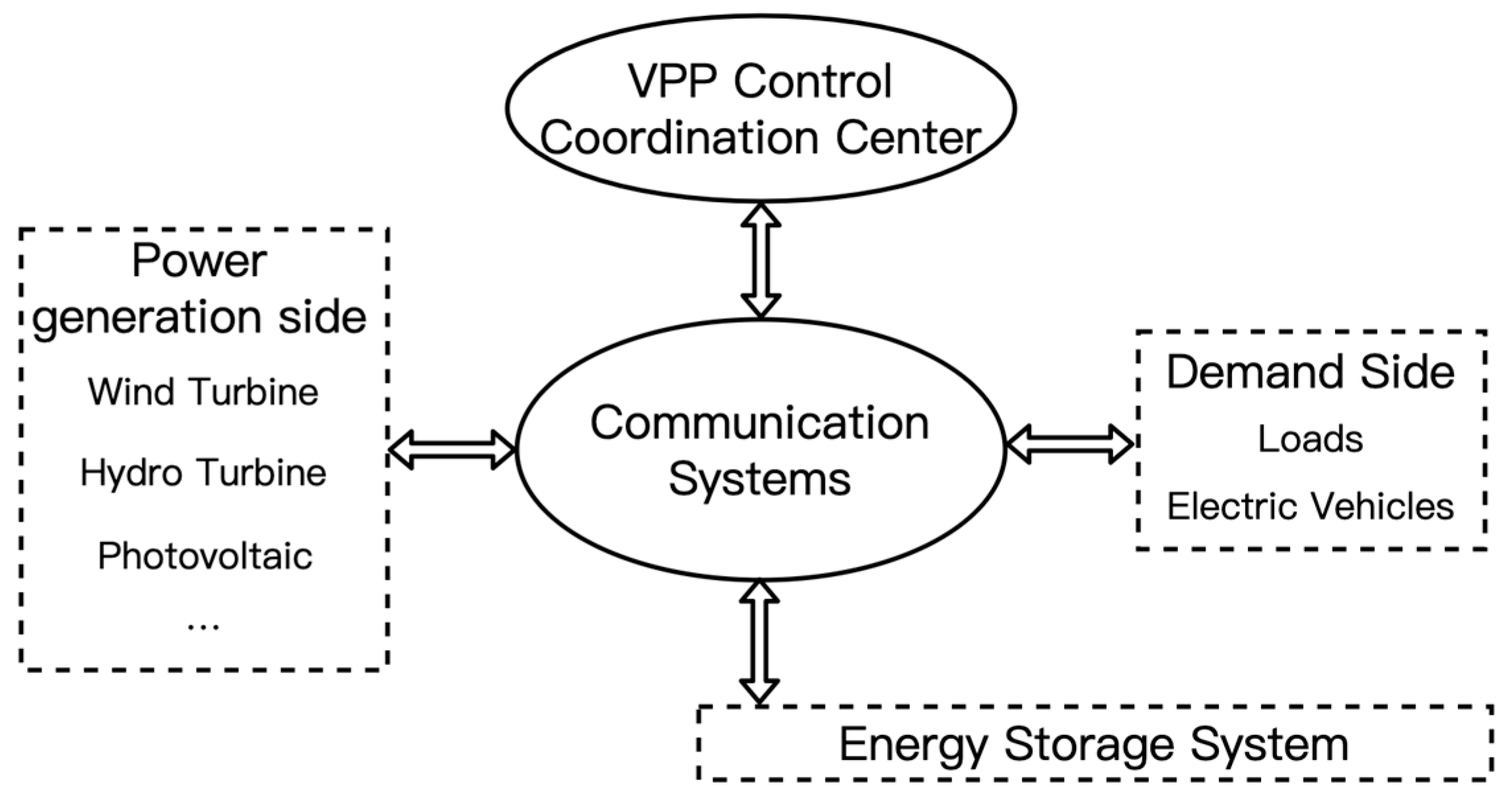



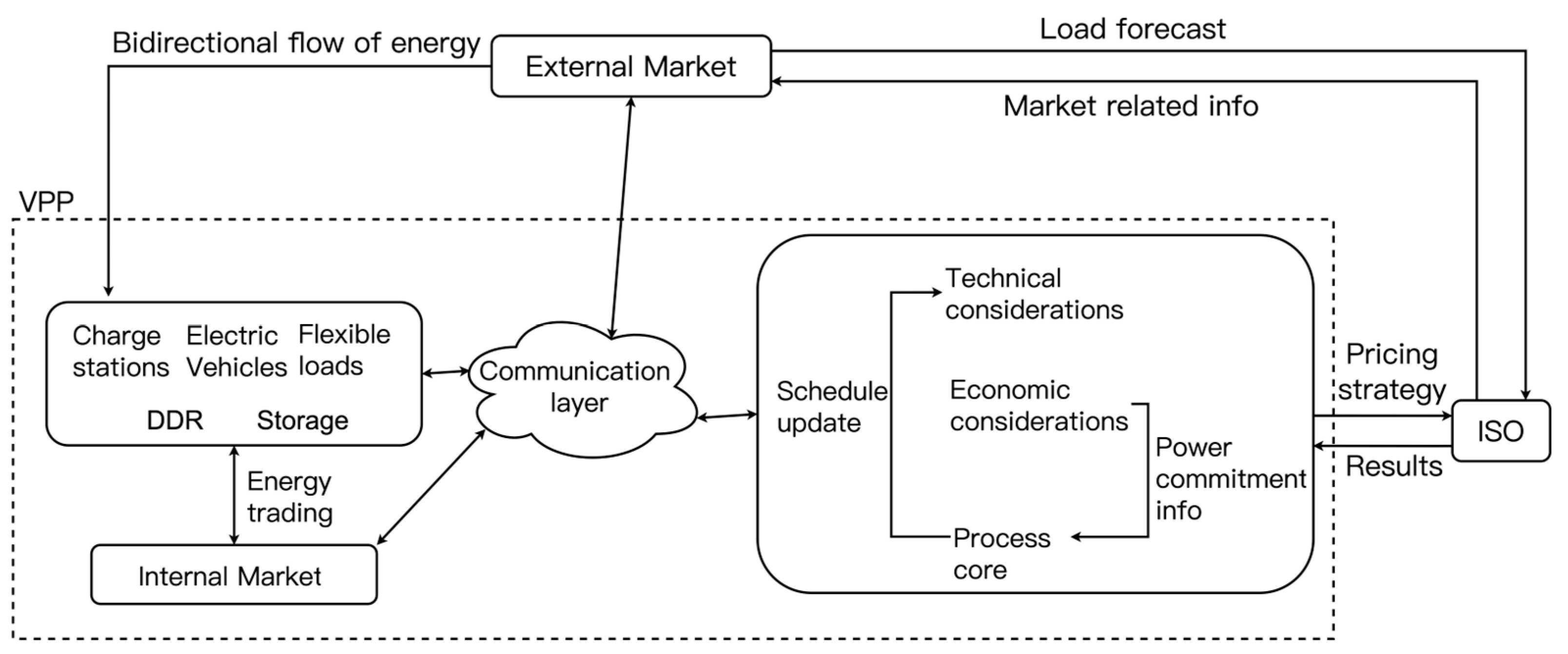
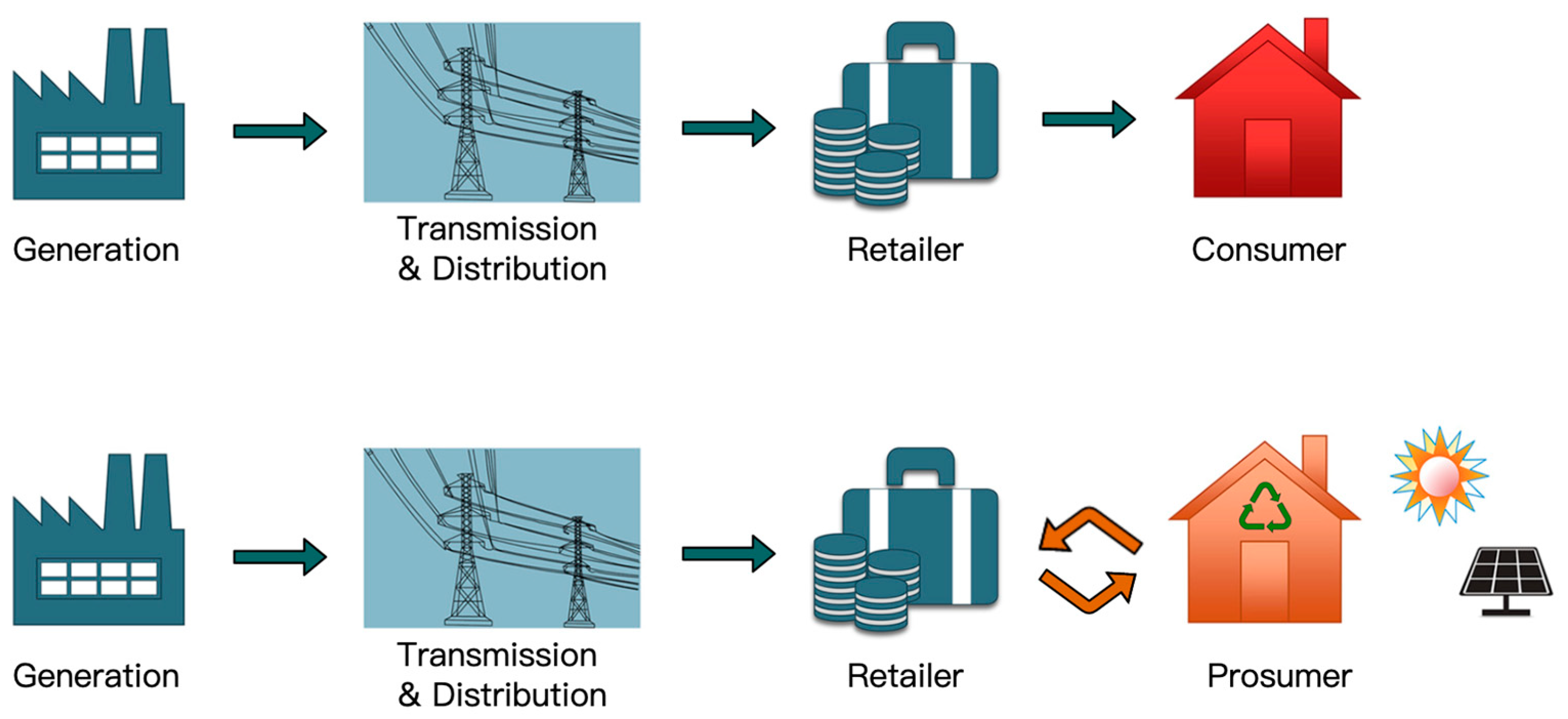
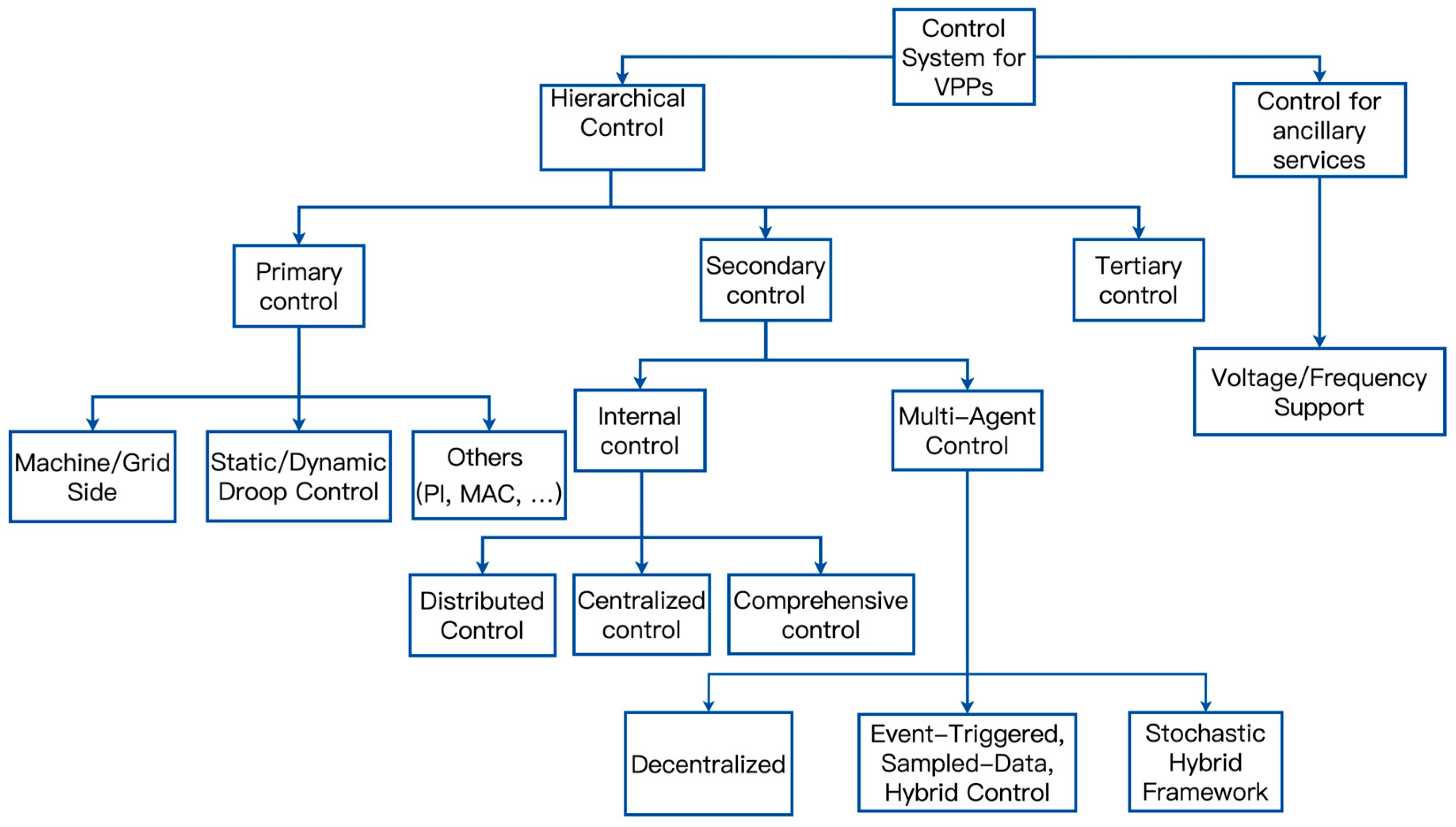
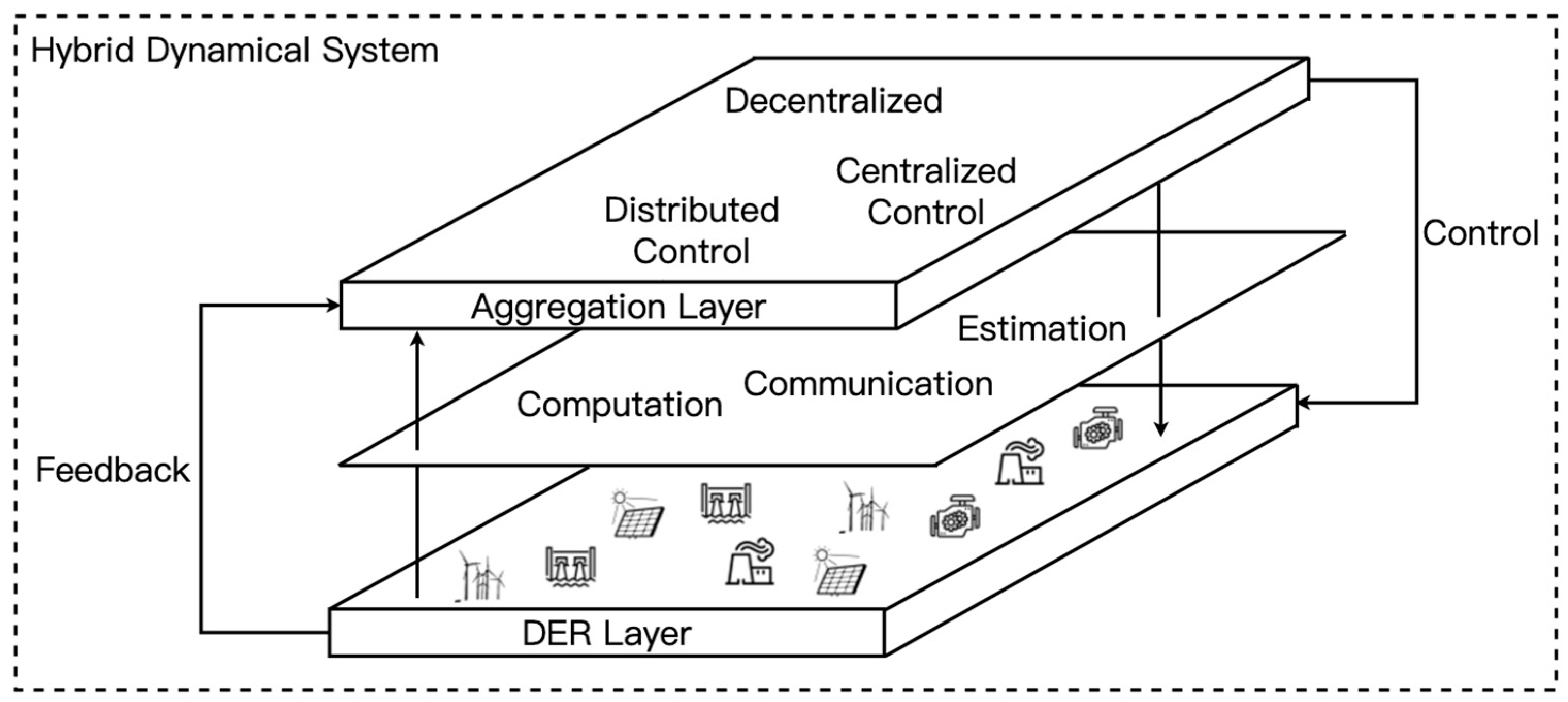
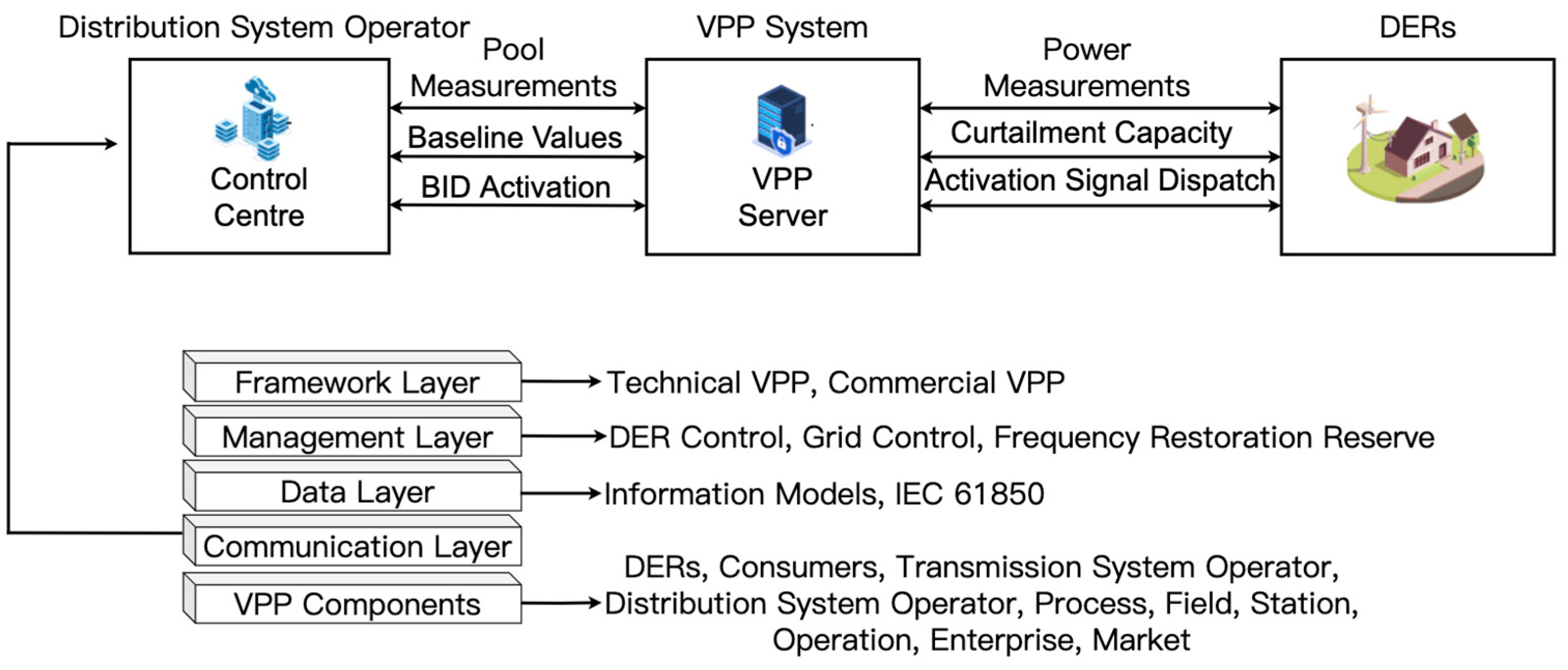
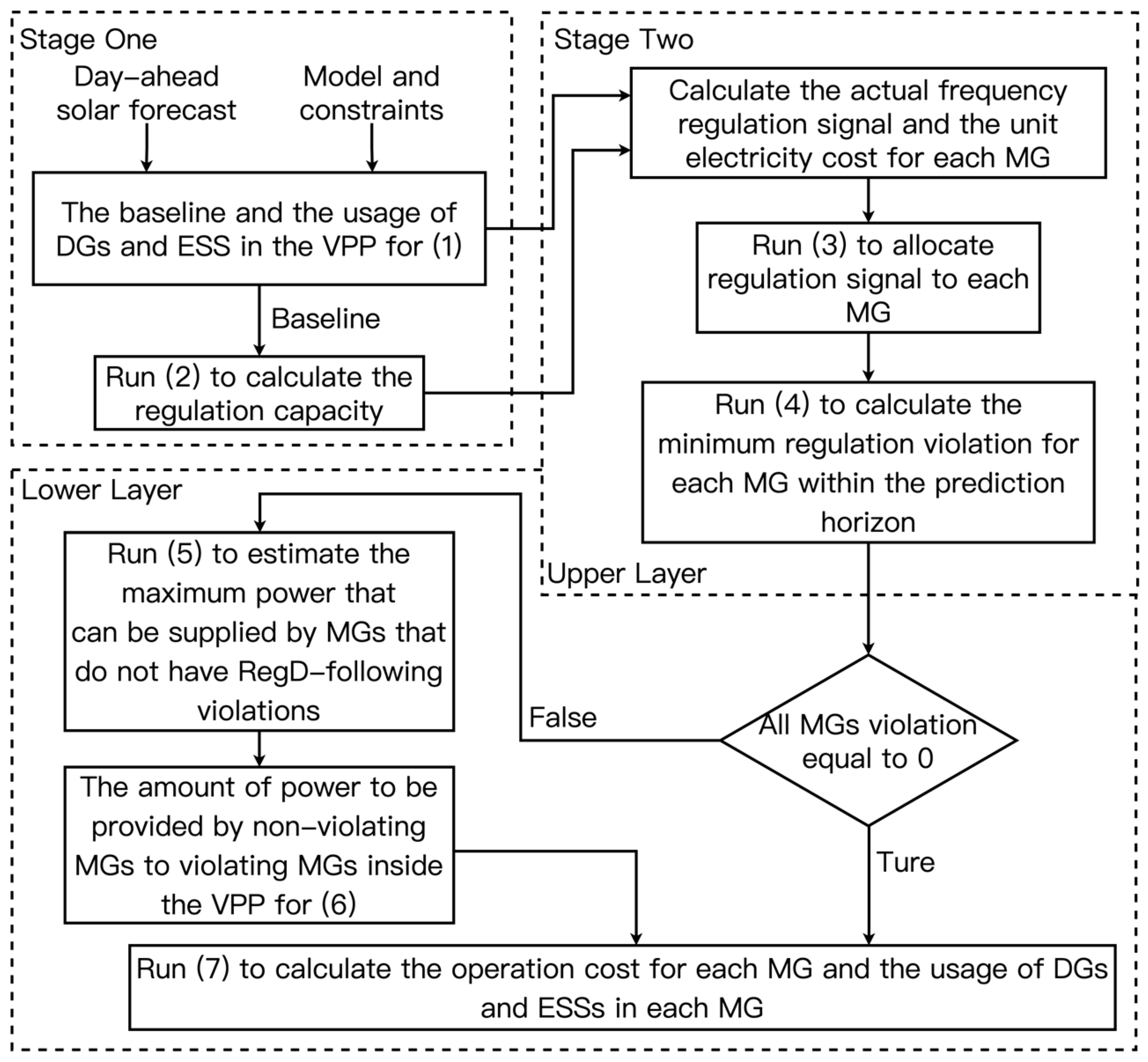
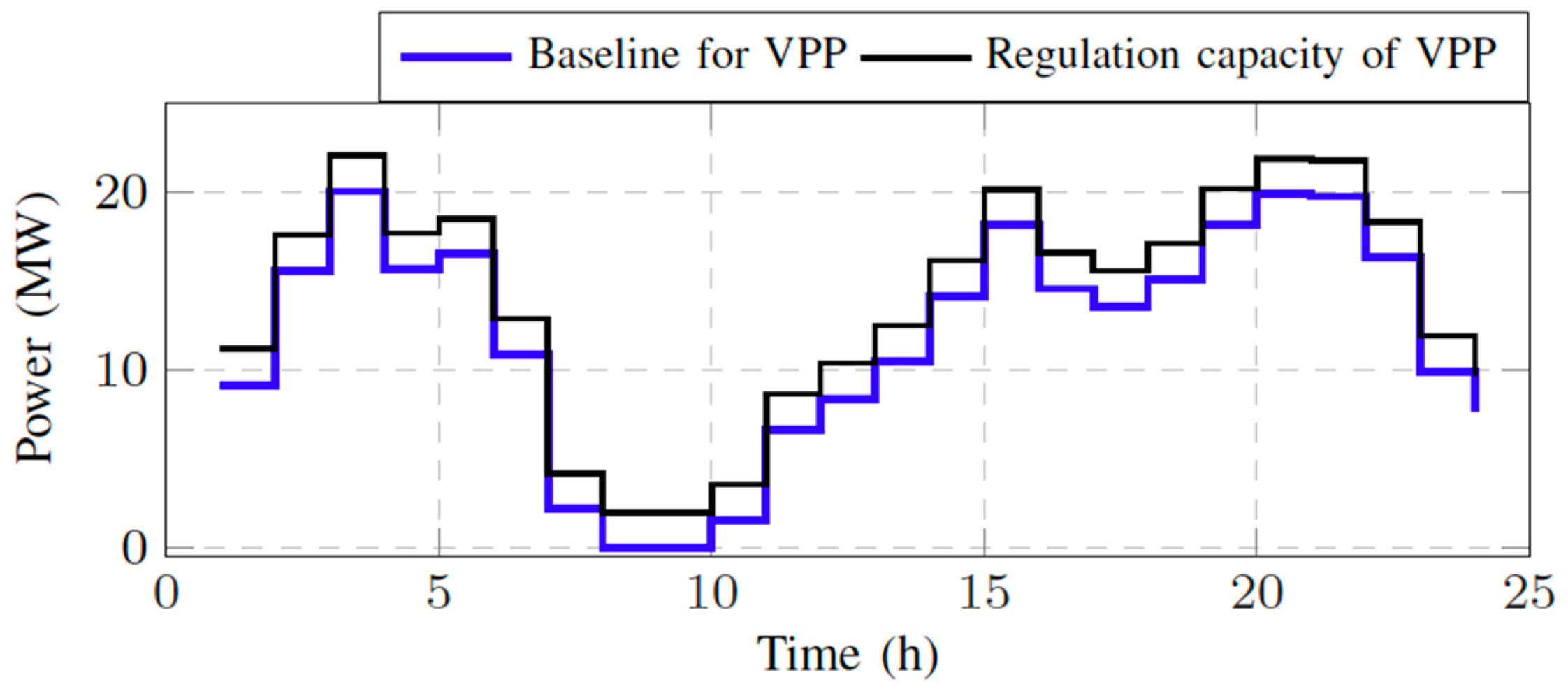
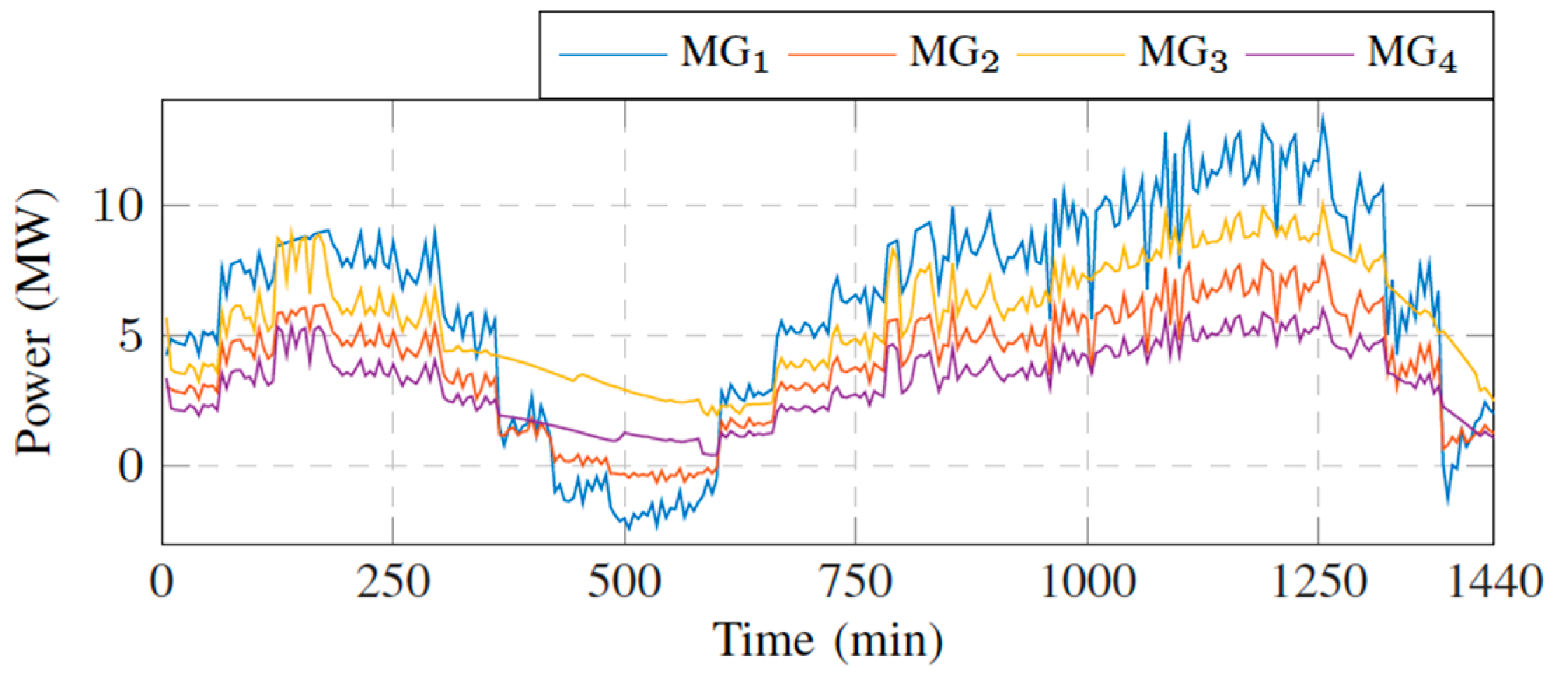
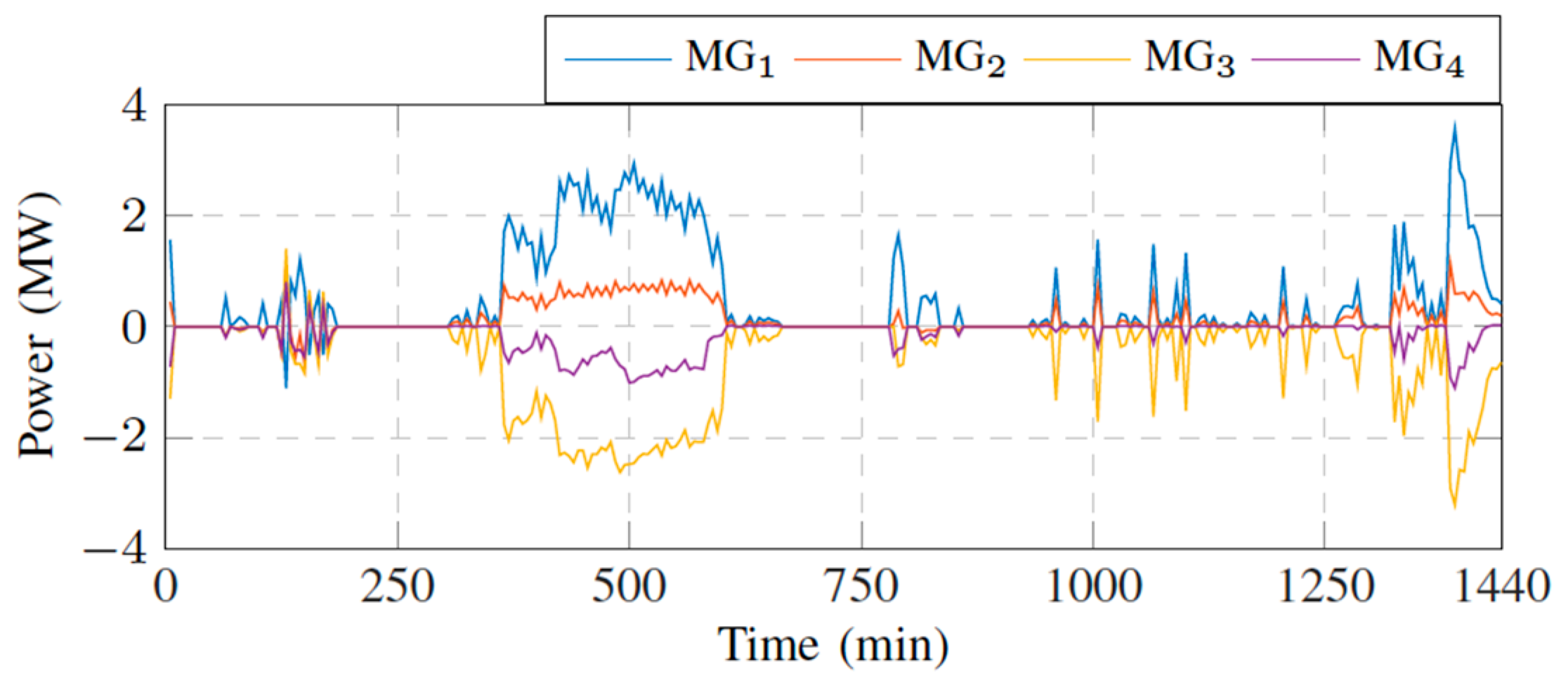
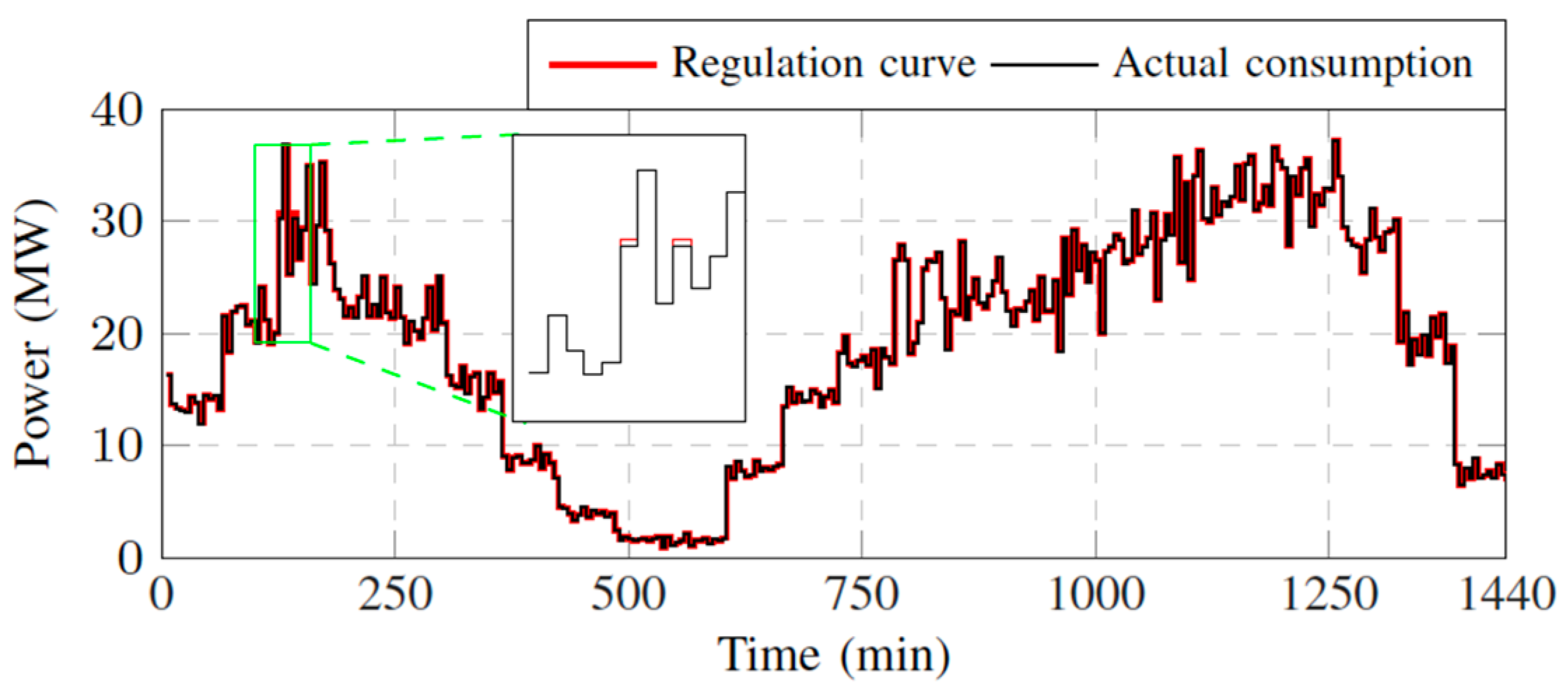
| Time | Brief Description | Reference |
|---|---|---|
| 1997 | VPPs were based on the definition of virtual public infrastructure, which describes a flexible collaboration between independent, market-driven entities to provide consumer-oriented energy services. | [31] |
| 2003 | The definition of VPPs was a combination of cogeneration units, small-scale RES, and EMS that effectively integrated VPPs into the electricity market. | [32] |
| 2004 | A new idea emerged involving clustering small generators near the load to provide heat and electricity. | [33] |
| 2007 | A widely accepted definition of VPPs was proposed as a flexible combination of DERs, which could aggregate many different DERs and create a single operational configuration file for control and management based on the parameters of each DER. | [34] |
| 2008 | VPPs and MGs were often mentioned together as the most effective solutions for integrating DERs into the power system, but they were different. | [35] |
| 2009 | Under the framework of an open electricity market, DG and controllable loads participated in real-time operation of the grid. The concept of VPPs included the integration of DERs, such as DGs, controllable loads, and EMS, into VPPs to make them more accessible and manageable in the energy market. | [36] |
| 2010 | Some definitions particularly emphasized the components of VPPs that rely on software systems for remote dispatch and optimization of the generation, storage resources, and demand-side services within a secure network system. | [37] |
| 2011 | Various methods were introduced to integrate electric vehicles into the power grid through the concept of VPPs. | [38] |
| 2014 | The concept of dynamic VPPs emerged, which reduced the operating costs of VPP by referring not only to market prices, but also to demand-side electricity predictions compared with traditional static VPPs. | [39] |
| 2017 | The concept of VPPs became more widely used as a power supplier for distribution networks, coordinating transmission system operators (TSOs) and distribution system operators (DSOs) to achieve different control objectives. | [40] |
| 2018 | VPPs were defined as a collection of DERs that participated as a single entity in the energy and reserve electricity market, aiming to benefit all system participants economically. | [41] |
| Brief Description | VPP | MG |
|---|---|---|
| Exist in grid-connected form only. | (Or off-grid) | |
| May or may not have ESSs. | (Require ESS) | |
| Can isolate themselves from the larger public grid as a contingency measure. | ||
| Rely on smart meters and information technology. | (Rely mainly on hardware) | |
| Combine and coordinate a variety of resources in a larger geographic area. | (Only include a set of static resources in a limited geographic location) | |
| Trade power with retails and wholesalers. | (Only trade at the retailer level) |
| Time | Brief Description | Reference |
|---|---|---|
| 2023 | A secondary frequency control strategy was proposed to offer emergency power support to systems in need through a high-voltage DC link of the voltage source converter. | [57] |
| 2023 | A VPP model was proposed to contain electric public transportation and distributed generator groups. A coordinated control strategy involving time-sharing planning and segmented execution was also proposed. | [58] |
| 2022 | A distributed real-time multi-objective control strategy was proposed, taking multiple DERs in the DC distribution network as VPPs for multi-objective optimization control. The proposed strategy aimed to achieve optimal performance by minimizing power losses, improving voltage stability, and reducing the overall operating cost of the DC distribution network. | [59] |
| 2022 | A stochastic mixed-integer linear programming model about technical VPPs to optimize DERs scheduling in the current energy market and analyze the effects on volts and power was proposed. The model took into consideration the uncertainties associated with the availability of DERs, electricity prices, and demand, and minimized the overall cost of energy procurement and management. This model improved the system’s ability to consolidate DERs, while enhancing some technical and operational indexes. | [60] |
| 2022 | A synchronous VPP framework for DERs based on grid-tied inverters was proposed to provide inertia support with parameter settings. The proposed VPP framework had several advantages over conventional generators for providing inertia support. | [61] |
| 2022 | A two-layer scheduling model for VPP was proposed to consider the interaction between the distribution company and VPPs. The upper layer reduced the associated costs of the distribution system by changing the electricity price traded with the VPP, while the lower layer VPP managed the quantity of electricity traded with the distribution system to increase VPP profits. | [62] |
| 2022 | A dual layer coordinated scheduling strategy for VPP was proposed as a comprise to electric vehicles and ESS. The VPP scheduled ESS using a direct control method. Furthermore, the interaction between VPP and electric vehicle owners was governed by Stackelberg games to maximize profit and minimize costs. | [63] |
| 2022 | A novel control method for dynamic VPPs was proposed utilizing an adaptive divide-and-conquer strategy. It involved obtaining dynamic VPP frequency and voltage control specifications for each device’s behavioral decomposition or aggregation and optimizing the best matches. | [64] |
| 2022 | The efficacy of five control strategies for distributed energy storage in residential VPPs was evaluated. These strategies included VPP bill minimization, single-household bill minimization, peak shaving, daytime peak shaving, and load balancing. | [65] |
| 2022 | A data-driven and fully distributed voltage/reactive power control method for numerous VPPs was proposed, and its effectiveness was demonstrated. Each VPP corrected its control strategy by using feedback from the local system and exchanging partial information with adjacent VPPs. | [66] |
| 2022 | A two-stage deep reinforcement learning method was proposed to manage DER aggregators that offer frequency regulation services. In the first stage, the agent considered the current system frequency, the available resources, and the desired response time to adjust the power output of the DERs in real time. In the second stage, a deep reinforcement learning-based policy optimization algorithm was used to optimize the overall system performance. | [67] |
| 2022 | A coordinated control strategy for load frequency control of VPPs comprising a battery ESS and heat pump water heater was proposed. The final solution was obtained using a fuzzy policy based on user-defined conditions. Furthermore, VPPs participating in frequency regulation could reduce the frequency deviation caused by communication delay. | [68] |
| 2021 | A two-tier power system scheduling and control architecture was proposed based on grid-friendly VPPs capable of flexibly and safely accommodating RESs and participating in power system stability control. This VPP facilitated the full use of RESs under normal circumstances and power support when unexpected events occurred. | [69] |
| 2021 | A control framework for optimizing multiple markets, systems, and local network services was introduced, mainly coordinating three optimization problems: day-ahead energy scheduling, linearized power flow, and real-time scheduling. It was verified that the framework achieved flexibility of VPPs. | [70] |
| 2021 | An abstract dynamic control method for VPPs combined with computational intelligence was proposed, which was flexibly applicable to different VPP models and verified the feasibility of the control method. | [71] |
| 2020 | A coordination control framework integrating VPP, and electric vehicles was designed, and a coordination control strategy for electric vehicles and ESSs was proposed to optimize output and extend battery life using a new storage optimization method. | [72] |
| 2020 | The new mode of community based VPPs as a source of energy supply, co-constituted by five building blocks (two of which comprised of information technology systems control architecture aggregation and control of DERs) in community energy. | [73] |
| Time | Brief Description | Reference |
|---|---|---|
| 2023 | With the aid of a multi-stage stochastic mixed-integer linear programming with binary resources and a novel decomposition algorithm, the optimization of VPP operations for day-ahead scheduling and auxiliary services could be enhanced. | [92] |
| 2022 | A new computing architecture using cloud-based energy trading and DR for managing VPP was proposed, by buying and selling electricity through a cloud-based energy trading platform to maximize revenue. | [93] |
| 2022 | A data-driven approach was created to jointly optimize the battery ESS and DR, targeting the maximization of VPP profits, as per the resource planning of a VPP. | [94] |
| 2021 | As for a VPP in the combined FCAS and DR markets, a FCAS and a critical threshold discount strategy based on cumulative prospect theory was proposed. This result was achieved with both demand-side producers and retailers of the VPP profiting from the appropriate formulation of a pricing model. | [95] |
| 2021 | Devoting attention to the optimal bidding strategy of a VPP comprised of photovoltaics, battery ESS, and controllable loads in the FCAS market was proposed, seeking to maximize the associated interests. | [96] |
| 2020 | A hierarchical control strategy was proposed for ancillary services of an aluminum smelter load (controllable load). On the upper level, monitoring computers estimated the available power and allocated reserves to loads through optimization. The underlying level controllable load automatically responded to frequency deviations by changing its power consumption. | [97] |
| 2019 | A fog computing approach to shape and manage VPPs to render auxiliary services was proposed. This fog-layered collaboration model catered to local energy systems, considering local obstructions, service restrictions, frequency reserves, and profit optimization. | [98] |
| 2019 | An entirely novel scheme was proposed for optimizing VPP operations and bidding strategies by scheduling DERs and DR, making it possible for VPPs to supply energy and auxiliary services to the grid. | [99] |
| 2019 | A new framework for VPP energy control was proposed based on DR, which minimized VPP operating costs, with risk-based constraints on day-ahead and real-time electricity prices, RESs generation processes, and DR uncertainty. | [50] |
| 2019 | A coordinated operation strategy for an active distribution network based on a two-layer agent framework and considering the electricity price response of DER was proposed. DER made its own decisions based on operability and economics, while an active distribution network coordinated each participant through the interactive benefit prioritization. | [100] |
| 2019 | A mixed integer linear constraint programming model was presented for simulating a battery ESS in the Italian ancillary services market to verify the economic viability of the storage technology when providing network services. | [101] |
| 2018 | The industrial switch loads (quickly adjusting power consumption through switches) were proposed to provide regulation or load tracks with the support of ESS and to provide auxiliary services. | [102] |
| 2018 | A combination of RES and ESS to generate power consumption signals was proposed, in order to participate in real-time regulation and provide auxiliary services by tracking dynamic regulation signals, maintaining grid stability, and obtaining economic benefits. The proposed method was validated in factory scheduling. | [49] |
| 2018 | A method of using an artificial neural network to predict future prices of electricity in the auxiliary energy market was proposed. This information could be used by participants in the market to make decisions about when to buy and sell electricity, and to optimize the use of DERs. | [103] |
| 2018 | This innovative approach involved integrating thermal energy supply equipment with ESS in multiple VPPs to provide frequency modulation services to the auxiliary service market. | [104] |
| 2017 | A scheduling model based on a resource−task network formulation (represents the production process as a set of tasks that require specific resources, such as machines, equipment, and personnel) was proposed that incorporated the flexibility of electric arc furnaces to adjust their power consumption to reduce electricity costs during peak demand periods. | [105] |
Disclaimer/Publisher’s Note: The statements, opinions and data contained in all publications are solely those of the individual author(s) and contributor(s) and not of MDPI and/or the editor(s). MDPI and/or the editor(s) disclaim responsibility for any injury to people or property resulting from any ideas, methods, instructions or products referred to in the content. |
© 2023 by the authors. Licensee MDPI, Basel, Switzerland. This article is an open access article distributed under the terms and conditions of the Creative Commons Attribution (CC BY) license (https://creativecommons.org/licenses/by/4.0/).
Share and Cite
Liu, J.; Hu, H.; Yu, S.S.; Trinh, H. Virtual Power Plant with Renewable Energy Sources and Energy Storage Systems for Sustainable Power Grid-Formation, Control Techniques and Demand Response. Energies 2023, 16, 3705. https://doi.org/10.3390/en16093705
Liu J, Hu H, Yu SS, Trinh H. Virtual Power Plant with Renewable Energy Sources and Energy Storage Systems for Sustainable Power Grid-Formation, Control Techniques and Demand Response. Energies. 2023; 16(9):3705. https://doi.org/10.3390/en16093705
Chicago/Turabian StyleLiu, Jiaqi, Hongji Hu, Samson S. Yu, and Hieu Trinh. 2023. "Virtual Power Plant with Renewable Energy Sources and Energy Storage Systems for Sustainable Power Grid-Formation, Control Techniques and Demand Response" Energies 16, no. 9: 3705. https://doi.org/10.3390/en16093705
APA StyleLiu, J., Hu, H., Yu, S. S., & Trinh, H. (2023). Virtual Power Plant with Renewable Energy Sources and Energy Storage Systems for Sustainable Power Grid-Formation, Control Techniques and Demand Response. Energies, 16(9), 3705. https://doi.org/10.3390/en16093705







